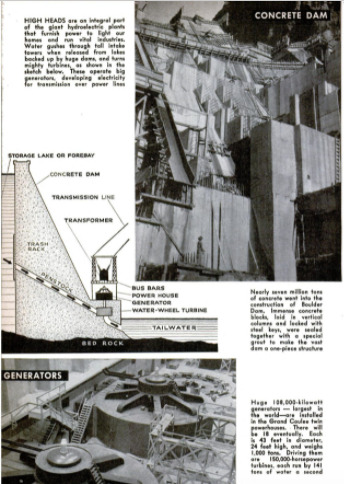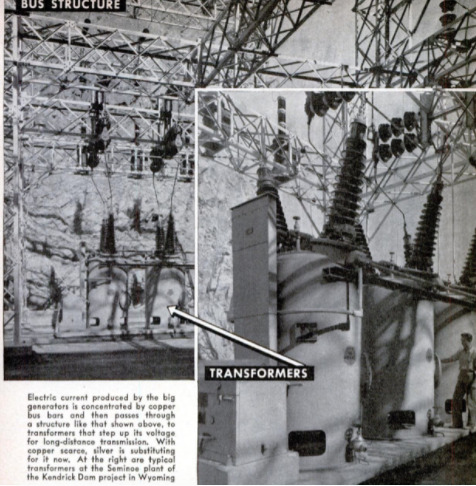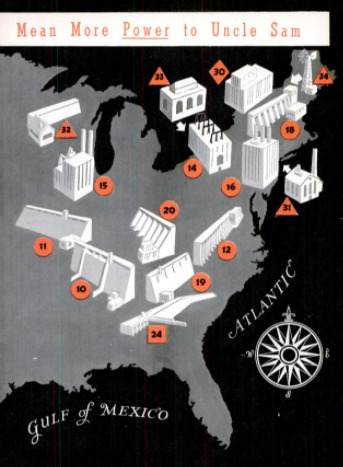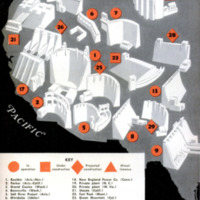-
Title (Dublin Core)
-
America will win the battle of Kilowatts
-
Article Title and/or Image Caption (Dublin Core)
-
Title: America will win the battle of Kilowatts
-
Subtitle: Our gigantic system of dams and powerhouses pump the lifeblood into vital war industries
-
extracted text (Extract Text)
-
ELECTRICITY is the lifeblood of modern
war production. We must have it in
vast quantities to produce aluminum for
airplanes and magnesium for bombs; to
heat-treat steel for gun barrels, ships’
plates, and tank armor; for the production
of chlorine and other chemicals. We must
have it to run the hundreds of thousands
of machine tools which are turning raw
metals into finished weapons. Just as im-
portant, we must have it to keep working
the everyday services on which depends
the sustained drive of our war effort—to
run streetcars and elevators; to keep radio
stations on the air and telephone and tele-
graph systems in operation: to light fac-
tories, mines, and streets.
In the crowded, vulnerable industrial
areas of Germany, power-generating sta-
tions are among the most carefully guard-
ed installations—and the favorite targets of
the R.A.F. One bomb neatly placed on a
German powerhouse can do more to cut off
the flow of arms and munitions to Hitler's
war machine than a score dropped on sepa-
rate factories. |
In this battle of the kilowatts, America
enjoys an immense advantage in the huge
hydroelectric plants that dot the country
from Grand Coulee on the Columbia to
Boulder Dam on the Colorado and from;
the falls of Niagara to the valley of the
Tennessee. On a thousand rivers and
streams, large and small hydroelectric
plants add their contributions to the mighty
torrent of electric power that is helping us
win the war. |
Late in 1942 we were using electric pow-
er at an all-time high of about 240 billion
kilowatt hours a year. Although only 30
percent of our generating plants are hydro-
electric, these are producing 40 percent of
our electricity. That they are of the great-
est importance in our war effort was proved
by last year’s increases over 1941 in the use
of electric power. On the Pacific Coast,
where nine tenths of the power generated
is hydroelectric and nearly all war indus-
tries are served by water-powered plants,
the increase was twice the average increase
for the nation. The adequate supply of low-
cost power assured by hydro-electric de-
velopments is an important consideration in
the location of war plants.
The proportion of
hydroelectric gener-
ating plants is increas-
ing steadily. Since
the earliest days of
the 60-year-old elec-
tric power industry
generators have been
driven by both steam
and water. Thomas A.
Edison opened the
first steam-powered
central station on
Pearl Street in down-
town New York in
September of 1882,
and a few days later
opened the first hy-
droelectric plant on
the Fox River at Ap-
pleton, Wis. But until
about 25 years ago,
because of the then
unsolved technical dif-
ficulties and high cost
of transmitting elec-
tric current over long
distances, hydroelec-
tric development had to be confined largely
to localities where water power was fairly
close to potential users of the electric pow-
er to be generated by it. Consequently,
more steam than water-power plants were
built. But methods
have been improved
until electric power
can be transmitted
economically for 300
miles, and now half
of the power-produc-
ing facilities under
construction are hy-
droelectric—nearlyall
of them Federal or
state owned.
Hydroelectricplants
are expensive to build,
but once built they
cost much less to op-
erate than do steam
plants. Little labor is
needed to keep them
running, they burn no
coal, and their eco-
nomic life is much
longer than the 20-
year average of steam
plants. Their most se-
rious disadvantage is
that sometimes their
power output is less
ened by droughts, but on many rivers
storage dams built upstream from the pow-
er dams assure uninterrupted production.
The hardest-to-break wartime bottleneck
in increasing hydroelectric power produc-
tion is the procurement of
turbines and generators.
They take about two
years to build and there
are only a few manu-
facturers who have the
equipment and highly
skilled workers neces-
sary for the job, Unfor-
tunately, these manufac-
turers also are the only
ones who can build
steam turbines for war-
ships and cargo vessels,
and the War Production
Board has ordered work
stopped on all power-
house equipment that
will not be finished by
early next year.
The mammoth dams
which tame and harness
mighty rivers for the
generation of electric
power are among the
most impressive of the
works of man, and their
building is made possible
only by brilliant pioneer
work in engineering. The
two most spectacular are,
of course, Boulder Dam
on the Colorado River
near Las Vegas, Nev., and
Grand Coulee on the
Columbia in the state of
‘Washington. One is the largest individual
power plant in operation anywhere in
the world; the other, when completed, will
dwarf it.
Boulder Dam is geared now to a generat-
ing capacity of 952,300 kilowatts with 12
of its projected 17 generators in action. It
produces over 31/3 billion kilowatt hours
of current annually, transmitting much of it
to plane factories in the Los Angeles area
over a 266-mile 285,000-volt double-tower
line—longest in existence and unparalleled
for high voltage. Grand Coulee, in opera-
tion only since 1941, has a present capacity
of 386,000 kilowatts, and two more 108,000-
kilowatt generators will go into service this
year. When all 18 are installed, Grand Cou-
lee will have a capacity of close to two mil-
lion kilowatts, or 13 billion kilowatt hours
a year. It is the biggest engineering struc-
ture that has ever been built by mankind.
The 115,000-horsepower turbines at
Boulder Dam are turned by water gushing
through four skyscraper-high intake towers
from Lake Mead, the largest man-made
reservoir in the world. Grand Coulee’s 150,-
000-horsepower turbines are fed by the
overflow of a 1,650-foot spillway which
forms a waterfall twice as high as Niagara.
And both these great plants are but units
—thongh the most impressive—in their
systems Boulder Dam is supplemented by
Parker Dam, 155 miles downstream, and
Davis Dam, midway between them, will be
finished after the war. Grand Coulee is in-
terconnected with Bonneville Dam, com-
pleted by Army Engineers in 1938 at the
head of tidewater on the Columbia. Seven
more dams are proposed to raise the Colum-
bia output to the
total of 90 billion kilowatt hours a year.
Boulder Dam and Grand Coulee were
built under contract with the Bureau of
Reclamation through a merger of six Pa-
cific Coast companies of which Henry Kai-
ser, more recently of ship-building and
cargo-plane fame, was a leader. Boulder
was in operation in 1936, six years after the
plans were drawn, two years ahead of
schedule. Construction required first the
building of railroads and motor roads and a
town for 5,000 workers and their families.
Before excavation for the foundation of the
dam, the river had to be diverted through
56-foot-diameter tunnels blasted through
three miles of canyon walls. Seven million
tons of concrete went into the dam itself,
poured into blocks 25 to 60 feet square and
cooled by ice water running through em-
bedded pipes. These blocks, piled in vast
vertical columns and locked together with
steel keys, were converted into a solid unit
by running a special grout concrete be-
tween them.
In addition to Boulder and Grand Coulee,
between 1908 and 1941 the Bureau of Recla~
mation built 26 smaller hydroelectric plants
on 15 projects in 11 Western and South
western states. Their aggregate generat-
ing capacity is close to a quarter million
kilowatts. Several large dams are under
construction—the biggest is 602-foot-high,
375,000-kilowatt Shasta Dam on the Sace
ramento River, keystone of the Central Val-
ley Project in northern California. It is
over three-quarters completed, but gener-
ators ordered for it have been installed at
Grand Coulee.
While our most spectacular water-power
developments are in the West, our largest
present hydroelectric system is on the other
side of the continent. It is composed of the
dozen interconnected power-producing dams
of the Tennessee Valley Authority on the
Tennessee River and its tributaries in
Tennessee, North Carolina, and Kentucky.
They have a total generating capacity of
nearly 1 1/2million kilowatts, more than 70
percent of which goes into war production
in the great aluminum, chemical, electro
metallurgical, munitions, and industrial
plants of this vital war-production area.
The oldest of these plants and the one
with the largest generating capacity—288,-
000 kilowatts—is Wilson Dam, started in
1918 to supply power to the World War
nitrate plants of the Muscle Shoals area.
Pickwick, Norris, Wheeler, and Chicka
mauga dams all have generating capacities
of over 100,000 kilowatts. Several new
dams are under construction—among them
the 450-foot Fontana Dam on the Little
Tennessee River in North Carolina, which
will be the highest dam east of the Rocky
Mountains and will have a generating
capacity of 200,000 kilowatts; Kentucky
Dam on the Tennessee River near Paducah,
Ky. which will be the biggest dam east of
the Mississippi and will have a generating
capacity of 126,000 kilowatts; Appalachia
Dam on the Hiwassee River; and Douglas
Dam on the French Broad River.
A number of large-scale hydroelectric de-
velopments have been undertaken by state
power authorities. The 130,000-kilowatt.
Bantee-Cooper project is nearing comple-
tion in South Carolina. Work has been
started on important developments on the
Lower Colorado and Brazos rivers in Texas.
‘While the greatest developments, requir-
ing enormous capital investments, have
been financed with the public's money, there
are many important privately owned hy-
droslectric plants. The largest ia the 178,
450-kilowatt. Schoelkopf Station of the Ni-
agara_ Hudson Power Corporation. The
Comerford plant of the Connecticut River
Power Company has a generating capacity
of 166,000 kilowatts, and is the largest in
New England. Conowingo Dam, In northern
Maryland, produces 11/3 billion kilowatt
hours of power a year. Operated In con-
Junction with two sother plants farther up
the Susquehanna River, it supplies power
to the vital Baltimore, Philadelphia, and
southern New Jersey industrial areas.
The end of the war almost certainly will
be the beginning of an era of tremendous
Government-financed hydroelectric develop-
ment. The Bureau of Reclamation will com-
plete projects on which it has suspended
work, and start several new ones. Several
states will go ahead with important power-
production projects now authorized. Hydro-
electric developments may be made more
attractive to private capital by advances in
the field of high-voltage power transmission
which will make possible the low-cost trans-
mission of water-power-generated electrici-
ty to localities many hundreds of miles from
where it is produced. A way may even be
found to stockpile electricity for use when
it is needed—an advance which would re-
duce production costs by obviating the
need for expensive stand-by generating
equipment which is used only when current
requirements are abnormally high.
-
Contributor (Dublin Core)
-
Arthur Grahame (Article Writer)
-
Language (Dublin Core)
-
eng
-
Date Issued (Dublin Core)
-
1943-04
-
pages (Bibliographic Ontology)
-
108-113, 216, 218
-
Rights (Dublin Core)
-
Public Domain (Google Digitized)
-
Archived by (Dublin Core)
-
Matteo Ridolfi
-
Marco Bortolami (editor)
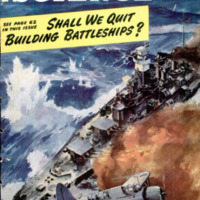 Popular Science Monthly, v. 142, n.4, 1943
Popular Science Monthly, v. 142, n.4, 1943

